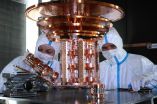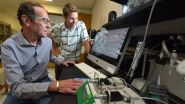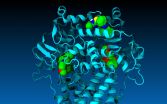(Press-News.org) CAMBRIDGE, Mass.--The boiling of water is at the heart of many industrial processes, from the operation of electric power plants to chemical processing and desalination. But the details of what happens on a hot surface as water boils have been poorly understood, so unexpected hotspots can sometimes melt expensive equipment and disable plants.
Now researchers at MIT have developed an understanding of what causes this extreme heating -- which occurs when a value known as the critical heat flux (CHF) is exceeded -- and how to prevent it. The new insights could make it possible to operate power plants at higher temperatures and thus significantly higher overall efficiency, they say.
The findings are reported this week in the journal Nature Communications, in a paper co-authored by mechanical engineering postdoc Navdeep Singh Dhillon, professor of nuclear science and engineering Jacopo Buongiorno, and associate professor of mechanical engineering Kripa Varanasi.
"Roughly 85 percent of the worldwide installed base of electricity relies on steam power generators, and in the U.S. it's 90 percent," Varanasi says. "If you're able to improve the boiling process that produces this steam, you can improve the overall power plant efficiency."
The bubbles of vapor that characterize boiling, familiar to anyone who has ever boiled water on a stove, turn out to limit energy efficiency. That's because gas -- whether it's air or water vapor -- is highly insulating, whereas water is a good absorber of heat. So on a hot surface, the more area that is covered with bubbles, the less efficient the transfer of heat energy becomes.
If those bubbles persist too long at a given spot, it can significantly increase the temperature of the metal underneath, since heat is not transferred away fast enough, Varanasi says -- and can potentially melt part of the metal.
"This will most certainly damage an industrial boiler, a potentially catastrophic scenario for a nuclear power plant or a chemical processing unit," says Dhillon. When a layer of bubbles limits heat transfer, "locally, the temperature can increase by several thousand degrees" -- a phenomenon known as a "boiling crisis."
To avoid exceeding the CHF, power plants are usually operated at temperatures lower than they otherwise could, limiting their efficiency and power output. Using textured surfaces has been known to help, but it has not been known why, or what the optimal texturing might be.
Contrary to prevailing views, the new work shows that more texturing is not always better. The MIT team's experiments, which use simultaneous high-speed optical and infrared imaging of the boiling process, show a maximum benefit at a certain level of surface texturing; understanding exactly where this maximum value lies and the physics behind it is key to improving boiler systems, the team says.
"What was really missing was an understanding of the specific mechanism that textured surfaces would provide," Buongiorno says. The new research points to the importance of a balance between capillary forces and viscous forces in the liquid.
"As the bubble begins to depart the surface, the surrounding liquid needs to rewet the surface before the temperature of the hot dry spot underneath the bubble exceeds a critical value," Varanasi says. This requires understanding the coupling between liquid flow in the surface textures and its thermal interaction with the underlying surface.
"If anything can enhance the heat transfer, that could improve the operating margin of a power plant," Varanasi says, allowing it to operate safely at higher temperatures.
By improving the overall efficiency of a plant, it's possible to reduce its emissions: "You can get the same amount of steam production from a smaller amount of fuel," Dhillon says. At the same time, the plant's safety is improved by reducing the risk of overheating, and catastrophic boiler failures.
INFORMATION:
The research was supported by Chevron Corp., the Kuwait-MIT Center for Natural Resources and the Environment, and a Shapiro fellowship from Mechanical Engineering Department. The micro-nano structured surfaces used in the study were fabricated in the Microsystems Technologies Labrotary (MTL) and at Harvard CNS.
This news release is available in German.
The Earth, planets, stars, and galaxies form only the visible portion of the matter in the universe. Greater by far is the share accounted for by invisible "dark matter". Scientists have searched for the particles of dark matter in numerous experiments - so far, in vain.
With the CRESST experiment, now the search radius can be considerably expanded: The CRESST detectors are being overhauled and are then able to detect particles whose mass lies below the current measurement range. As a consequence, the chance of tracking ...
Washington, DC (September 8, 2015) - The modern-day complaints department tends to be a direct mention on Twitter to the company that has wronged you. It's easier than ever to have a direct line to a company, but what does a corporation get out of this interaction? A recent study published in the Journal of Computer-Mediated Communication by researchers at VU University Amsterdam, The Netherlands, found that people who follow corporate social media accounts that present a human voice are more likely to have a positive view of the company.
Corné Dijkmans (NHTV Breda ...
Sticky resin from conifers contains substances that could relieve or cure epilepsy. Researchers at Linköping University have synthesized and tested 71 substances known as resin acids, of which twelve are prime candidates for new medicines.
"Our goal is to develop some of the most potent substances into medicines," says Fredrik Elinder, professor of molecular neurobiology and head of the study, which was newly published in Nature's open-access periodical Scientific Reports.
Professor Elinder is an expert on the function of ion channels - the pores in the cell membrane ...
Individual transistors made from carbon nanotubes are faster and more energy efficient than those made from other materials. Going from a single transistor to an integrated circuit full of transistors, however, is a giant leap.
"A single microprocessor has a billion transistors in it," said Northwestern Engineering's Mark Hersam. "All billion of them work. And not only do they work, but they work reliably for years or even decades."
When trying to make the leap from an individual, nanotube-based transistor to wafer-scale integrated circuits, many research teams, including ...
Typhoon Kilo continues to thrive in the Northwestern Pacific and imagery from NASA's Terra satellite late on September 7 showed that the storm still maintained a clear eye.
The MODIS or Moderate Resolution Imaging Spectroradiometer instrument that flies aboard Terra provided a visible-light image of Kilo on September 7 at 23:50 UTC (7:50 p.m. EDT). The image showed thick bands of thunderstorms wrapping around the eastern and northern quadrants of the visible eye.
At 0900 UTC (5 a.m. EDT) on September 9, Typhoon Kilo had maximum sustained winds near 65 knots (74.8 mph/120.4 ...
This news release is available in French.
Montreal, September 8, 2015 -- All countries have contributed to recent climate change, but some much more so than others. Those that have contributed more than their fair share have accumulated a climate debt, owed to countries that have contributed less to historical warming.
This is the implication of a new study published in Nature Climate Change, in which Concordia University researcher Damon Matthews shows how national carbon and climate debts could be used to decide who should pay for the global costs of climate ...
Scientists at Texas A&M University have made additional progress in understanding the process behind scar-tissue formation and wound healing -- specifically, a breakthrough in fibroblast-to-fibrocyte signaling involving two key proteins that work together to promote fibrocyte differentiation to lethal excess -- that could lead to new advances in treating and preventing fibrotic disease.
A new study led by biologists Richard Gomer and Darrell Pilling and involving Texas A&M graduate students Nehemiah Cox and Rice University technician Varsha Vakil points to a naturally ...
Contrary to popular belief, the worst injuries baseball catchers face on the field come from errant bats and foul balls, not home-plate collisions with base runners, according to findings of a study led by researchers at the Johns Hopkins University School of Medicine.
The research, done in collaboration with Baltimore Orioles trainers Brian Ebel and Richard Bancells, involved analysis of all catcher injuries during major league baseball games over a 10-year period.
A summary of the findings, published ahead of print Aug. 28 in the American Journal of Sports Medicine, ...
AUGUSTA, Ga. - The regular physical trauma that appears to put professional football players at risk for degenerative brain disease may also increase their risk for hypertension and cardiovascular disease, researchers say.
The frequent hits football players experience, particularly frontline defenders such as linemen, likely continually activate the body's natural defense system, producing chronic inflammation that is known to drive blood pressure up, according to a study in The FASEB Journal.
While strenuous physical activity clearly has its benefits, it also produces ...
Researchers at Southern Methodist University, Dallas, have discovered three new drug-like compounds that could ultimately offer better odds of survival to prostate cancer patients.
The drug-like compounds can be modified and developed into medicines that target a protein in the human body that is responsible for chemotherapy resistance in cancers, said biochemist Pia D. Vogel, lead author on the scientific paper reporting the discovery.
So far there's no approved drug on the market that reverses cancer chemotherapy resistance caused by P-glycoprotein, or P-gp for short, ...





